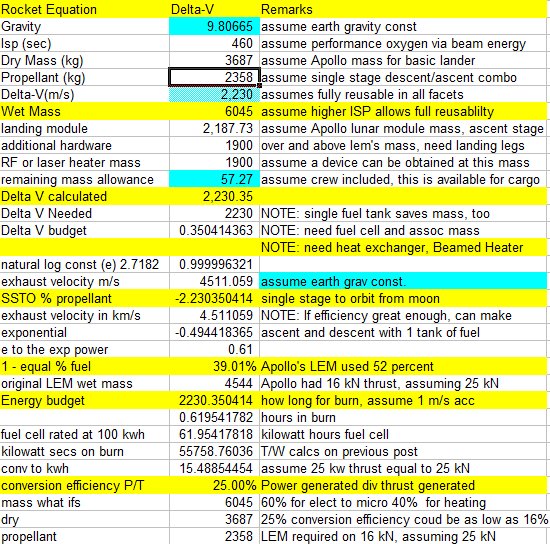In case you are not familiar, this is
Dennis Wingo's book about In Situ Resourcing on the moon. It was an inspiration for the book, Platinum Moon,
discussed previously on this blog with respect to LENR.
It isn't new material, so there's not a lot to say. Something occurred to me in connection with the recent debt negotiations. There was an idea to
use a coin to retire debt, then to raise new debt so as to fund the government. Why not fund Wingo's idea to fund a concept to mine
pgms and then use those pgms to finance the enterprise?
It would work like this: the mission would finance it with bonds purchased by the Fed. That's like Quantitative Easing, but the twist is to retire the debt when the platinum comes back from the moon. That is, to make coins from the platinum mined from the moon. How many coins? That would depend upon the denomination that you need to choose.
For example, if you were to bring back 1 metric ton, it would raise 39 billion dollars if the coins were denominated at a million apiece. If 10 tons were to be brought back, it would be reduced to 100k, and so forth.
Wingo's ideas wouldn't require that much money, according to his book. So, $39 billion would give plenty of wiggle room. He believes there could be a lot of pgms on the moon due to asteroidal impacts. He says that rich deposits of pgms on Earth are of the same type. In fact, if this theory is correct, and it appears to be good reason to believe that it is, we are already using asteroidal metals. That explains the logic of his proposal. So, if the pgms came to Earth by way of asteroidal impacts, it should be true for the moon as well.
There is some iffy parts to this, of which the presence of pgms is one. Another is the financing scheme just outlined. There are those who would find fault with this idea, I'm sure. But it would be legal, as far as I know.
Technically, it appears quite doable, as Wingo lays it out in detail. On the Space Show recently, he said he doubted that the government would do his type of proposal. ( By conventional financing, not like this financing proposal I just mentioned, which is shall we say, "creative".)
That means that private industry would have to undertake the project, but are the amounts of money he discusses "a bridge too far"? He doesn't think so, but the speculative part about the pgms would possibly make it so. In that case, somebody would have to do a prospecting mission to look for pgms, and that may not be too far outside of the realm of possibilities.
Yet, if the government did it, that part wouldn't be too ambitious. But is the government interested? He seems to be doubtful on this point.
If the government is not, it may take the private sector to do it all, just like in the book Platinum Moon. But there ought to be a way to do these things, because money should not be an issue, provided that the proposition is sound.
Update:
I did some checking on the internet with respect to the metal value of a coin. A
Sacajawea coin is worth about 3 cents for its metal. That's a 30 to 1 ratio. For collectible coins, the market value can be a multiple of its face value. Let's say another 30 to 1 ratio. In other words, a coin that costs the government 3 cents to make can be sold for nearly 1000 times what it cost to obtain the metal to make it.
Now, let's look at platinum. It can be bought on the open market now for about the price of gold - 1600 an ounce. If you multiply 1600 times 1000 you get 1.6 million dollars for each coin. So, asking putting a face value of 1 million on each coin is not out of the question. Most likely, people will not want to collect it though.
If you were to coin 35,200 of them at 1 million apiece, you would obtain the 35 billion dollars. This would take 1 metric ton of the metal to do it. Would there be 35,200 "purchases" of a coin struck of lunar platinum? Making it legal tender would obviate the need to sell it. If you coined 35,000 of them at 100k, you would only raise $3.5 billion. But at 100k, you get closer to the same ratio that you have with the ordinary currency.
Lunar platinum coins would be worth more than an ordinary coin because of its novelty. Plus if it was a limited edition coin such as this, it would have even greater value. You could probably give it a 100k denomination and then sell it on the market for whatever it could bring. Hopefully, it could fetch a premium on the face value, comparable to the Susan B Anthony dollar, thus recovering all of the debt and retiring it without costing the government a dime.
All of this from mining and refining on the lunar surface 1 metric ton of platinum. The 2002 output of platinum in the USA was about 4 times that number, according to Wingo's book. If they got really lucky, they may find a motherload worth a lot more than that.
It's worth looking into, don't you think?
Update:
The Sacajawea coin costs about 6 cents. That is a bit different, but it could still work.
Update:
I tweeted and Facebooked this post. I welcome any criticism of the idea. Tell me where this is wrong.


















